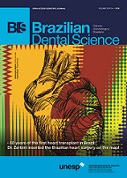Effect of different surface treatments on the ceramic veneer surface: morphological analysis
DOI:
https://doi.org/10.14295/bds.2018.v21i1.1533Resumo
Objective: The aim of this study was to evaluate the effect of different surface clinical treatments on the roughness (Ra) of a lithium disilicate ceramic veneer. Material and Methods: Forty-eight lithium disilicate discs with ceramic veneer and glaze layer were manufactured and distributed into six groups (n=8) according to the surface treatment performed: G1, glaze layer (control group); G2, diamond bur 4138F; G3, diamond bur 4138F + 4138FF; G4, diamond bur 4138F + new glaze layer; G5, diamond bur 4138F + ceramic polishing kit; G6, diamond bur 4138F + rubber cup with diamond paste + felt with diamond paste. Surface Ra measurement (µm) was performed using a profilometer before and after surface treatments, and one specimen from each group was subjected to Scanning Electron Microscopy (SEM) after treatment. Two-way ANOVA and Tukey's test (5%) were used for data analysis. Results: Group 2 (3,00 ± 0,61)b showed higher values of Ra, followed by Group 3 (1,93 ± 0,45)c, Group 6 (1,56 ± 0,22)ac, Group 5 (1,14 ± 0,68)a and Group 4 (0,90 ± 0,26)a. G4, G5 and G6 were not different between each other and control group (1,11 ± 0,21)a. SEM imaging revealed surface smoothness in G1, G4 and G5, and presence of irregularities in G2, G3 and G6. Conclusion: it is possible to conclude that different surface clinical treatments influences the roughness of a lithium disilicate ceramic veneer.
Keywords: Ceramics; Dental porcelain; Dental polishing.
Downloads
Downloads
Publicado
Como Citar
Edição
Seção
Licença
TRANSFERÊNCIA DE DIREITOS AUTORAIS E DECLARAÇÃO DE RESPONSABILIDADE
Toda a propriedade de direitos autorais do artigo "____________________________________________________________________" é transferido do autor(es) para a CIÊNCIA ODONTOLÓGICA BRASILEIRA, no caso do trabalho ser publicado. O artigo não foi publicado em outro lugar e não foi submetido simultaneamente para publicação em outra revista.
Vimos por meio deste, atestar que trabalho é original e não apresenta dados manipulados, fraude ou plágio. Fizemos contribuição científica significativa para o estudo e estamos cientes dos dados apresentados e de acordo com a versão final do artigo. Assumimos total responsabilidade pelos aspectos éticos do estudo.
Este texto deve ser impresso e assinado por todos os autores. A versão digitalizada deverá ser apresentada como arquivo suplementar durante o processo de submissão.




























